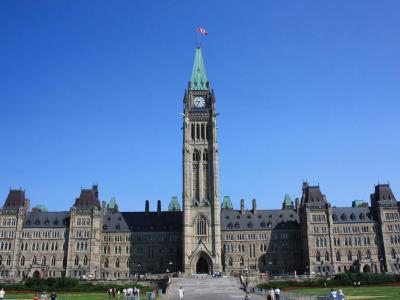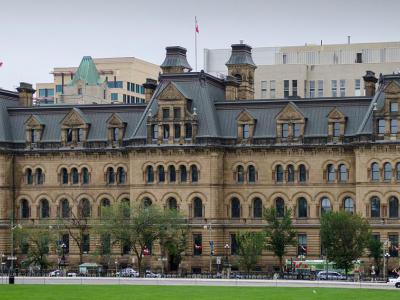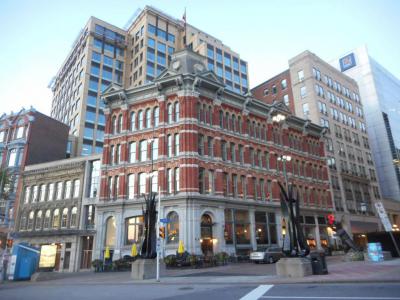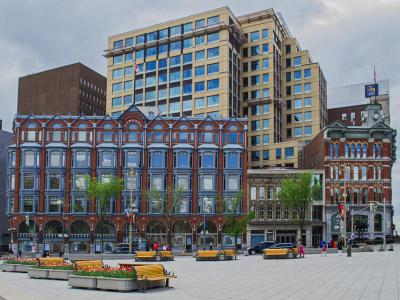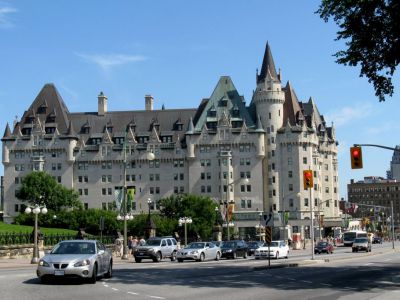Historical Buildings Walking Tour (Self Guided), Ottawa
The architecture of Ottawa – formalistic and functional, for the most part – is marked by the city's role as the national capital of Canada. As such, it represents a mix of styles, varying considerably based on the era of construction of any particular object, and reflects the nation's heritage and political significance.
Centermost among these structures is the Parliament Building's Gothic Revival complex, designed to represent the federal authority.
The Peace Tower, a prominent feature on Parliament Hill, stands as a symbol of peace and remembrance. It houses the Memorial Chamber, honoring those who sacrificed their lives for the country. Nearby, the Office of the Prime Minister Building is where the nation's leader conducts crucial governmental affairs.
The Scottish Ontario Chambers, Central Chambers, and Bell Block are remarkable examples of Victorian-era architecture. These buildings showcase ornate details and historic charm, providing a glimpse into Ottawa's 19th-century ambiance.
A jewel along the Rideau Canal, the Fairmont Château Laurier epitomizes grandeur and opulence. This iconic hotel is an architectural marvel, hosting dignitaries and visitors alike in a luxurious setting.
The Connaught Building, a fine piece of Tudor Gothic, is a testament to Canada's commitment to public service. It has been home to various government departments over the years.
The Former Geological Survey of Canada Building and Notre-Dame Cathedral Basilica also add to Ottawa's architectural diversity. The former, with its neoclassical design, showcases Canada's scientific endeavors, while the latter, a stunning Gothic Revival cathedral, is a spiritual and artistic masterpiece.
As the living witnesses of Canada's past, these landmarks serve as tangible links to its political processes and cultural heritage. To truly appreciate Ottawa's historical buildings in their variety, consider embarking on this self-guided tour and explore them at your own pace.
Centermost among these structures is the Parliament Building's Gothic Revival complex, designed to represent the federal authority.
The Peace Tower, a prominent feature on Parliament Hill, stands as a symbol of peace and remembrance. It houses the Memorial Chamber, honoring those who sacrificed their lives for the country. Nearby, the Office of the Prime Minister Building is where the nation's leader conducts crucial governmental affairs.
The Scottish Ontario Chambers, Central Chambers, and Bell Block are remarkable examples of Victorian-era architecture. These buildings showcase ornate details and historic charm, providing a glimpse into Ottawa's 19th-century ambiance.
A jewel along the Rideau Canal, the Fairmont Château Laurier epitomizes grandeur and opulence. This iconic hotel is an architectural marvel, hosting dignitaries and visitors alike in a luxurious setting.
The Connaught Building, a fine piece of Tudor Gothic, is a testament to Canada's commitment to public service. It has been home to various government departments over the years.
The Former Geological Survey of Canada Building and Notre-Dame Cathedral Basilica also add to Ottawa's architectural diversity. The former, with its neoclassical design, showcases Canada's scientific endeavors, while the latter, a stunning Gothic Revival cathedral, is a spiritual and artistic masterpiece.
As the living witnesses of Canada's past, these landmarks serve as tangible links to its political processes and cultural heritage. To truly appreciate Ottawa's historical buildings in their variety, consider embarking on this self-guided tour and explore them at your own pace.
How it works: Download the app "GPSmyCity: Walks in 1K+ Cities" from Apple App Store or Google Play Store to your mobile phone or tablet. The app turns your mobile device into a personal tour guide and its built-in GPS navigation functions guide you from one tour stop to next. The app works offline, so no data plan is needed when traveling abroad.
Historical Buildings Walking Tour Map
Guide Name: Historical Buildings Walking Tour
Guide Location: Canada » Ottawa (See other walking tours in Ottawa)
Guide Type: Self-guided Walking Tour (Sightseeing)
# of Attractions: 8
Tour Duration: 1 Hour(s)
Travel Distance: 1.9 Km or 1.2 Miles
Author: helenp
Sight(s) Featured in This Guide:
Guide Location: Canada » Ottawa (See other walking tours in Ottawa)
Guide Type: Self-guided Walking Tour (Sightseeing)
# of Attractions: 8
Tour Duration: 1 Hour(s)
Travel Distance: 1.9 Km or 1.2 Miles
Author: helenp
Sight(s) Featured in This Guide:
- Peace Tower
- Office of the Prime Minister Building
- Scottish Ontario Chambers
- Central Chambers and Bell Block
- Fairmont Château Laurier
- Connaught Building
- Former Geological Survey of Canada Building
- Notre-Dame Cathedral Basilica
1) Peace Tower
Peace Tower is one of the most prominent buildings in Canada. It is an iconic image that can be recognized by anyone who has seen a Canadian $20 bill. Peace Tower can be found in the center of the Centre Block of Parliament on Parliament Hill.
Peace Tower was built in 1916 as a replacement for the previous clock tower, Victoria Tower, which was lost in a fire. Peace Tower was designed by architects Jean Omer Marchand and John A. Pearson in the same Victorian High Gothic style as the rest of the buildings in the area. The tower is designed with friezes, grotesques, gargoyles, stone carvings and arched windows.
Visitors can explore Peace Tower as part of the free Centre Block tour. Those lucky visitors who arrive at the right time can watch the changing of the guard. On summer nights, tourists can watch the Northern Lights Sights and Sounds show. The show lights up all of the Centre Block with Peace Tower prominently featured.
Peace Tower was built in 1916 as a replacement for the previous clock tower, Victoria Tower, which was lost in a fire. Peace Tower was designed by architects Jean Omer Marchand and John A. Pearson in the same Victorian High Gothic style as the rest of the buildings in the area. The tower is designed with friezes, grotesques, gargoyles, stone carvings and arched windows.
Visitors can explore Peace Tower as part of the free Centre Block tour. Those lucky visitors who arrive at the right time can watch the changing of the guard. On summer nights, tourists can watch the Northern Lights Sights and Sounds show. The show lights up all of the Centre Block with Peace Tower prominently featured.
2) Office of the Prime Minister Building
Right across from Parliament Hill stands a sandstone landmark that quietly commands attention – the office that runs the country, though you’ll only glimpse it from the street. Formerly known as the Langevin Block, this handsome Second Empire-style building has been the nerve center of Canadian power since 1889. Designed by Chief Dominion Architect Thomas Fuller (also responsible for the original Parliament Buildings), it was the first federal structure built beyond the Hill’s precincts.
The sandstone came from New Brunswick, quarried from the Green and Fish site – chosen after a long back-and-forth between Fuller and the builder, and in part responsible for the building’s distinctive warm hue and elegant carvings.
These days, it houses the Prime Minister’s Office and the Privy Council Office where key decisions are quietly shaped. You can’t go inside, but that golden-hued façade, bridging history and modern governance, makes it a striking stop on any Ottawa walk.
The sandstone came from New Brunswick, quarried from the Green and Fish site – chosen after a long back-and-forth between Fuller and the builder, and in part responsible for the building’s distinctive warm hue and elegant carvings.
These days, it houses the Prime Minister’s Office and the Privy Council Office where key decisions are quietly shaped. You can’t go inside, but that golden-hued façade, bridging history and modern governance, makes it a striking stop on any Ottawa walk.
3) Scottish Ontario Chambers
Situated prominently on Ottawa's Confederation Square, where Sparks and Elgin's streets intersect, stands the Scottish Ontario Chambers-a notable four-story brick building. With its striking multicolored masonry, fenestration, and roofline, this corner structure stands out among its surroundings. Its historical significance is limited to the physical area it occupies.
Constructed in 1883, the Scottish Ontario Chambers showcases excellent aesthetic design, reflecting the Victorian Italianate style. The renowned architect William Hodgson, who also designed the adjacent Bell Block building, was responsible for its creation. This building exemplifies the characteristics of a large-scale late Victorian business block, boasting a well-balanced facade and ornate brickwork.
In comparison to other commercial blocks on Sparks Street during the 19th century, it stands twice as tall and exhibits a functional design. The ground floor serves as retail space, while the upper stories house offices, featuring one of the city's earliest elevators. The meticulous craftsmanship is evident in the intricate stonework and decorative brickwork, including the use of radiated voussoirs crafted from multicolored bricks.
Constructed in 1883, the Scottish Ontario Chambers showcases excellent aesthetic design, reflecting the Victorian Italianate style. The renowned architect William Hodgson, who also designed the adjacent Bell Block building, was responsible for its creation. This building exemplifies the characteristics of a large-scale late Victorian business block, boasting a well-balanced facade and ornate brickwork.
In comparison to other commercial blocks on Sparks Street during the 19th century, it stands twice as tall and exhibits a functional design. The ground floor serves as retail space, while the upper stories house offices, featuring one of the city's earliest elevators. The meticulous craftsmanship is evident in the intricate stonework and decorative brickwork, including the use of radiated voussoirs crafted from multicolored bricks.
4) Central Chambers and Bell Block
Central Chambers is a significant structure situated at the intersection of Elgin Street and Queen Street in Ottawa. Recognized as a National Historic Site, the building stands adjacent to Bell Block. Its prominent position faces the Canadian War Memorial located in Confederation Square. Constructed between 1890 and 1893, Central Chambers exemplifies the Queen Anne Revival style of commercial architecture and was designed by John James Browne of Montreal. Originally serving as an office for the Canadian Atlantic Railway, it now serves as the headquarters of the National Capital Commission.
In the 1960s, the NCC acquired the building, which remained unoccupied for a significant portion of the 1970s and 1980s. In 1992, plans were formulated to renovate Central Chambers, leading to the interior being gutted and the facade integrated into a new office tower complex. Its architectural and historical significance was officially recognized in 1990 when it was designated as a National Historic Site of Canada due to its exemplary representation of the Queen Anne Revival style in commercial architecture.
Bell Block is another notable building situated in Ottawa. It is positioned between Central Chambers and Scottish Ontario Chambers. Constructed in 1867 based on a design by William Hodgson (1827–1904), Bell Block has been recognized as a heritage property under Part IV of the Ontario Heritage Act. The City of Ottawa also honored it with an "Award of Excellence" for its architectural significance.
In the 1960s, the NCC acquired the building, which remained unoccupied for a significant portion of the 1970s and 1980s. In 1992, plans were formulated to renovate Central Chambers, leading to the interior being gutted and the facade integrated into a new office tower complex. Its architectural and historical significance was officially recognized in 1990 when it was designated as a National Historic Site of Canada due to its exemplary representation of the Queen Anne Revival style in commercial architecture.
Bell Block is another notable building situated in Ottawa. It is positioned between Central Chambers and Scottish Ontario Chambers. Constructed in 1867 based on a design by William Hodgson (1827–1904), Bell Block has been recognized as a heritage property under Part IV of the Ontario Heritage Act. The City of Ottawa also honored it with an "Award of Excellence" for its architectural significance.
5) Fairmont Château Laurier
Nestled on Rideau Street opposite Parliament Hill, the Fairmont Château Laurier towers like a fairy-tale castle in the heart of Ottawa. Commissioned by railroad magnate Charles Melville Hays in 1908, the hotel opened in 1912 but in a twist worthy of a novel, Hays perished aboard the Titanic en route to the grand opening. Fun fact: did you know the dining-room furniture he ordered for the hotel was packed on that same ill-fated ship-and went down with it?
Designed by Montreal’s Ross and MacFarlane, the Château Laurier flaunts the Châteauesque style – conical turrets, copper roofs, floral gables, and Indiana limestone facades inspired by France’s Loire Valley. Inside, lavish details unfold: Tiffany stained-glass windows, Belgian marble floors, hand-molded plaster ceilings, and an Adam Room echoing 18th-century elegance.
Over the decades, it has hosted royalty, wartime leaders, and icons – from Nelson Mandela to Princesses and Prime Ministers, earning the nickname “the third chamber of Parliament.” Sir Wilfrid Laurier himself opened the hotel in person after the tragic delay.
Legend has it that the ghost of Charles Melville Hays still wanders the halls, probably looking for his lost Titanic dinner reservation. Guests have also reported mysterious footsteps and sudden chills, perfect for those who enjoy a little spooky side with their luxury stay!
Tip: Pause in the lobby and admire the original Tiffany windows, then imagine the titanic twist that shaped this landmark forever.
Designed by Montreal’s Ross and MacFarlane, the Château Laurier flaunts the Châteauesque style – conical turrets, copper roofs, floral gables, and Indiana limestone facades inspired by France’s Loire Valley. Inside, lavish details unfold: Tiffany stained-glass windows, Belgian marble floors, hand-molded plaster ceilings, and an Adam Room echoing 18th-century elegance.
Over the decades, it has hosted royalty, wartime leaders, and icons – from Nelson Mandela to Princesses and Prime Ministers, earning the nickname “the third chamber of Parliament.” Sir Wilfrid Laurier himself opened the hotel in person after the tragic delay.
Legend has it that the ghost of Charles Melville Hays still wanders the halls, probably looking for his lost Titanic dinner reservation. Guests have also reported mysterious footsteps and sudden chills, perfect for those who enjoy a little spooky side with their luxury stay!
Tip: Pause in the lobby and admire the original Tiffany windows, then imagine the titanic twist that shaped this landmark forever.
6) Connaught Building
The Connaught Building in Ottawa is a historic office building owned by Public Services and Procurement Canada. It's located on MacKenzie Avenue, next to the American Embassy. With a beautiful view of the Byward Market to the east, it is surrounded by MacKenzie Avenue and Major's Hill Park to the west. Currently, it houses the Canada Revenue Agency (CRA) headquarters and offices for the Minister and Commissioner of the CRA.
The Connaught Building was designed in a Tudor-Gothic style by chief architect David Ewart. Construction work began in 1913 and was completed in 1915. The building was named after the Duke of Connaught, the third son of Queen Victoria and the 10th Governor General of Canada from 1911 to 1916. With seven levels above ground and one basement level, it stood as an impressive structure.
In 1971, the Connaught Building underwent extensive renovations that involved the addition of two levels. These were created by constructing floors within the generous ceiling heights of the basement and ground floors. Consequently, the building now consists of two basement levels and eight levels above ground on the Sussex Drive side, with the third floor having direct access to MacKenzie Avenue at street level.
The Connaught Building was designated a National Historic Site of Canada in 1990. Additionally, it has held the status of a "Federal Heritage Building" with "Classified" protection since 1988, signifying the highest level of safeguarding for federally owned structures.
The Connaught Building was designed in a Tudor-Gothic style by chief architect David Ewart. Construction work began in 1913 and was completed in 1915. The building was named after the Duke of Connaught, the third son of Queen Victoria and the 10th Governor General of Canada from 1911 to 1916. With seven levels above ground and one basement level, it stood as an impressive structure.
In 1971, the Connaught Building underwent extensive renovations that involved the addition of two levels. These were created by constructing floors within the generous ceiling heights of the basement and ground floors. Consequently, the building now consists of two basement levels and eight levels above ground on the Sussex Drive side, with the third floor having direct access to MacKenzie Avenue at street level.
The Connaught Building was designated a National Historic Site of Canada in 1990. Additionally, it has held the status of a "Federal Heritage Building" with "Classified" protection since 1988, signifying the highest level of safeguarding for federally owned structures.
7) Former Geological Survey of Canada Building
The Former Geological Survey of Canada Building is a historic three-story structure situated at the intersection of Sussex Drive and George Street in Ottawa's Byward Market area. It was originally occupied by the Geological Survey of Canada and has been recognized as a National Historic Site due to its age and significance. Throughout its history, the building has housed various public and cultural institutions.
The George Street wing of the building was built in 1863 by businessmen James Skead and Edward Griffen. It was initially Skead's Hotel, but Griffen later sold his share. The building became the George Street Barracks and served as a military barracks from 1864 to 1871. After a period of vacancy, it was purchased in 1875 by William Mills, a restaurateur, and operated briefly as the Clarendon House Hotel.
In 1879, Canada acquired the property for the Geological Survey of Canada. It also hosted the first exhibition of the Canadian Academy of Arts in 1880, which became the National Gallery of Canada's initial collection. The building underwent renovations that year to accommodate the Geological and Natural History Survey of Canada's offices and museum. The museum attracted 9,549 visitors in its first year, contributing to the development of Canada's national museums.
The George Street wing of the building was built in 1863 by businessmen James Skead and Edward Griffen. It was initially Skead's Hotel, but Griffen later sold his share. The building became the George Street Barracks and served as a military barracks from 1864 to 1871. After a period of vacancy, it was purchased in 1875 by William Mills, a restaurateur, and operated briefly as the Clarendon House Hotel.
In 1879, Canada acquired the property for the Geological Survey of Canada. It also hosted the first exhibition of the Canadian Academy of Arts in 1880, which became the National Gallery of Canada's initial collection. The building underwent renovations that year to accommodate the Geological and Natural History Survey of Canada's offices and museum. The museum attracted 9,549 visitors in its first year, contributing to the development of Canada's national museums.
8) Notre-Dame Cathedral Basilica (must see)
Notre-Dame Cathedral Basilica is a true Ottawa treasure – a stunning blend of history, art, and faith right in the city’s heart. This basilica stands where Ottawa’s first Catholic chapel once welcomed parishioners back in the early 19th century, making it the oldest surviving church in the capital. Construction began in 1841, but here’s a fun twist: the original plan was a Neo-classical design, which got a major makeover mid-way when Father Telmon stepped in and switched things up to the now-iconic Neo-Gothic style. So, when you look closely, you’ll spot this unique architectural mashup – classical at the base and soaring Gothic elegance above.
Step inside, and you’ll be greeted by a riot of color and detail that outshines the church’s more modest exterior. The stained glass windows flood the space with vibrant light, telling biblical stories in jewel-like hues. You’ll also find countless statues scattered throughout, with the gold-plated Madonna statue flanked by twin spires standing out as a shining star – literally and figuratively.
Did you know? The basilica has hosted some of Canada’s most significant moments, including the funerals of Governor General Georges Vanier and Prime Minister Sir Wilfrid Laurier, making it a place of deep national importance beyond its spiritual role.
Visitors can explore the basilica freely, and guided tours in English and French are available at no cost, perfect if you want to dig into the stories behind the art and architecture. Don’t miss the marble pillars, though: they’re actually wood cleverly painted to look like marble, a neat detail that’s easy to overlook but adds to the basilica’s charm.
Tip: Check the tour schedule online before you go to catch a guided tour and learn all the hidden stories and secrets tucked inside this magnificent basilica.
Step inside, and you’ll be greeted by a riot of color and detail that outshines the church’s more modest exterior. The stained glass windows flood the space with vibrant light, telling biblical stories in jewel-like hues. You’ll also find countless statues scattered throughout, with the gold-plated Madonna statue flanked by twin spires standing out as a shining star – literally and figuratively.
Did you know? The basilica has hosted some of Canada’s most significant moments, including the funerals of Governor General Georges Vanier and Prime Minister Sir Wilfrid Laurier, making it a place of deep national importance beyond its spiritual role.
Visitors can explore the basilica freely, and guided tours in English and French are available at no cost, perfect if you want to dig into the stories behind the art and architecture. Don’t miss the marble pillars, though: they’re actually wood cleverly painted to look like marble, a neat detail that’s easy to overlook but adds to the basilica’s charm.
Tip: Check the tour schedule online before you go to catch a guided tour and learn all the hidden stories and secrets tucked inside this magnificent basilica.
Walking Tours in Ottawa, Canada
Create Your Own Walk in Ottawa
Creating your own self-guided walk in Ottawa is easy and fun. Choose the city attractions that you want to see and a walk route map will be created just for you. You can even set your hotel as the start point of the walk.
Ottawa's Historical Churches Walking Tour
The city of Ottawa has a number of notable religious sites fit to spark interest in both ardent believers and those keen on ecclesiastical architecture. With most of the churches located in the downtown area or nearby, one can visit these locations without trouble.
The Notre Dame Cathedral Basilica, a splendid Gothic Revival masterpiece, is a centerpiece of Ottawa's spiritual landscape.... view more
Tour Duration: 2 Hour(s)
Travel Distance: 3.2 Km or 2 Miles
The Notre Dame Cathedral Basilica, a splendid Gothic Revival masterpiece, is a centerpiece of Ottawa's spiritual landscape.... view more
Tour Duration: 2 Hour(s)
Travel Distance: 3.2 Km or 2 Miles
Ottawa Introduction Walking Tour
Perched on the banks of the Ottawa River, the Canadian capital has story that began long before Parliament’s iconic Gothic towers pierced the skyline. For thousands of years, this land was home to the Algonquin Anishinaabe people, whose traditional territory stretched along the river’s length. The word “Ottawa” itself comes from adawe, meaning “to trade,” a nod to the waterway’s... view more
Tour Duration: 2 Hour(s)
Travel Distance: 2.8 Km or 1.7 Miles
Tour Duration: 2 Hour(s)
Travel Distance: 2.8 Km or 1.7 Miles
Statues and Sculptures Walk
As a cultural city, Ottawa abounds in monuments and statues of various sorts. In fact, there are so many of them that the locals, accustomed to their presence, jokingly claim they hardly notice them at all. Still, these artistic creations serve as visual storytellers, sharing tales of courage, peacekeeping, and commemoration.
The Maman Statue, a prominent sculpture located outside the National... view more
Tour Duration: 1 Hour(s)
Travel Distance: 1.4 Km or 0.9 Miles
The Maman Statue, a prominent sculpture located outside the National... view more
Tour Duration: 1 Hour(s)
Travel Distance: 1.4 Km or 0.9 Miles
The Most Popular Cities
/ view all



